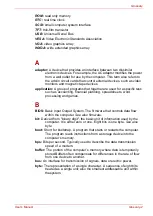
User’s Manual
Glossary-6
Glossary
L
Light Emitting Diode (LED):
A semiconductor device that emits light when
a current is applied.
Liquid Crystal Display (LCD):
Liquid crystal sealed between two sheets of
glass coated with transparent conducting material. The viewingside
coating is etched into character forming segments with leadsthat
extend to the edge of the glass. Applying a voltage between the
glass sheets alters the brightness of the liquid crystal.
LSI:
Large Scale Integration. 1) A technology that allows the inclusion of up
to 100,000 simple logic gates on a single chip.
2) An integrated circuit that uses large scale integration.
M
megabyte (MB):
A unit of data storage equal to 1024 kilobytes.
See also
kilobyte.
mode:
A method of operation, for example, the boot mode, Sleep mode or
the hibernation mode.
modem:
Derived from modulator/demodulator, a device that converts
(modulates) digital data for transmission over telephone lines and
then converts modulated data (demodulates) to digital format where
received.
monitor:
A device that uses rows and columns of pixels to display
alphanumeric characters or graphic images.
See also CRT.
MP3:
An audio compression standard that enables high-quality
transmission and real-time playback of sound files.
N
numeric keypad overlay:
A feature that allows you to use certain keys on
the keyboard to perform numeric entry, or to control cursor and page
movement.
O
operating system:
A group of programs that controls the basic operation
of a computer. Operating system functions include interpreting
programs, creating data files, and controlling the transmission and
receipt (input/output) of data to and from memory and peripheral
devices.
output:
The results of a computer operation. Output commonly indicates
data. 1) printed on paper, 2) displayed at a terminal, 3) sent through
the serial port of internal modem, or 4) stored on some magnetic
media.



































